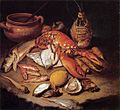Giacomo Ceruti
Giacomo Ceruti | |
|---|---|
Genre |
Giacomo Antonio Melchiorre Ceruti (13 October 1698 – 28 August 1767) was an Italian late Baroque painter, active in Northern Italy in Milan, Brescia, and Venice. He acquired the nickname Pitocchetto (the little beggar) for his many paintings of peasants dressed in rags.
He was born in Milan, but worked primarily in Brescia. He may have been influenced early by
Ceruti gave particular attention to this subject matter during the period 1725 to 1740, and about 50 of his genre paintings from these years survive.[1] Mira Pajes Merriman, in her essay titled Comedy, Reality, and the Development of Genre Painting in Italy, observes that "Generally his figures do almost nothing—after all, they have nothing to do."[2] She describes his paintings as confronting us with
the detritus of the community; the displaced and homeless poor; the old and the young with their ubiquitous spindles, eloquent signs of their situationless poverty and unwanted labour; orphans in their orderly, joyless asylums plying their unpaid toil; urchins of the streets eking out small coins as porters, and sating them in gambling; the diseased, palsied, and deformed; lonely vagabonds; even a stranger from Africa—and all in tatters and filthy rags, almost all with eyes that address us directly...[2]

A characteristic painting is his Woman with a Dog which portrays a rather plain subject sympathetically and without
Gallery
-
Dwarf
-
Beggar Resting
-
Spinner Woman,Museo di Santa Giulia, Brescia
-
Porter Boy Resting (1736), Pinacoteca di Brera, Milan
-
Encounter in Woods
-
Beggar Girl and Woman Spinning
-
Women Sewing Lace
-
Sleeping Pilgrim
-
The Laundress (1735), Pinacoteca Tosio Martinengo, Brescia
-
Three Beggars
-
Porters in Cardgame (also Evening at the Piazza) (1730), Palazzo Madama, Turin
-
Boy with Basket of Fish
-
Hen, Pot, and Onion
-
Lobster, Fish, & Shellfish
-
Bread and Pitcher
-
D. Alba Regina del Ferro
-
Portrait
-
Portrait
-
Smoking Man in Turban
-
Madonna & Saints, Altarpiece
Notes
Resources
- Spike, John T. (1986). Giuseppe Maria Crespi and the Emergence of Genre Painting in Italy. Fort Worth: Kimball Museum of Art. pp. 66–67.
External links
- Painters of reality: the legacy of Leonardo and Caravaggio in Lombardy, an exhibition catalog from The Metropolitan Museum of Art (fully available online as PDF), which contains material on Ceruti (see index)




















